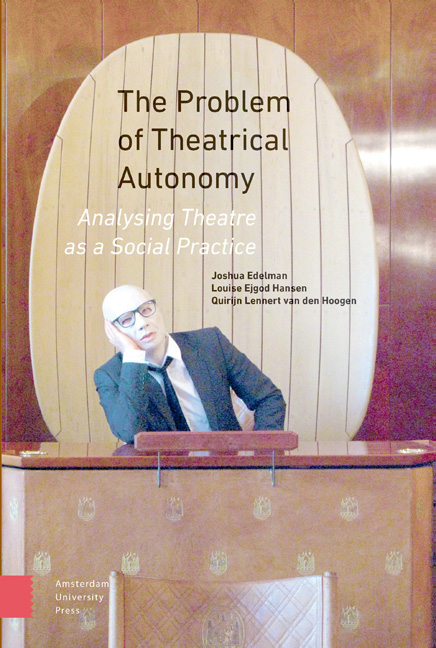Book contents
- Frontmatter
- Acknowledgements
- Contents
- List of Figures and Tables
- Introduction
- 1 How Can we Define Autonomy?
- 2 The Concept of Artistic Autonomy
- 3 Autonomy in the Contemporary Theatre
- 4 How Agents in Theatre Fields Make use of Claims to Autonomy
- 5 How Theatre Organization Shapes Claims to Autonomy
- 6 How Claims to Autonomy Serve those Outside Theatre Fields
- Conclusion
- References
- About the Authors
- Index
1 - How Can we Define Autonomy?
Published online by Cambridge University Press: 12 February 2021
- Frontmatter
- Acknowledgements
- Contents
- List of Figures and Tables
- Introduction
- 1 How Can we Define Autonomy?
- 2 The Concept of Artistic Autonomy
- 3 Autonomy in the Contemporary Theatre
- 4 How Agents in Theatre Fields Make use of Claims to Autonomy
- 5 How Theatre Organization Shapes Claims to Autonomy
- 6 How Claims to Autonomy Serve those Outside Theatre Fields
- Conclusion
- References
- About the Authors
- Index
Summary
In ordinary English, the word ‘autonomy’ is used to mean something very close to ‘freedom’. So, for many people, the term ‘the autonomy of the arts’ would seem to refer to the freedom of artists to make the work they wish to, how they wish to and where they wish to, without political or ethical constraints. But this is not what we mean by autonomy in this book. Here, we propose autonomy as a structural property of social fields. This is an essential difference. We want to propose that autonomy is a part of the basic structure of an area of human activity that we will call a social ‘field’. These fields are social spaces in which people come together to pursue the same sorts of practices so that they all understand, more or less, what others are doing, and thus are able to work with one another cooperatively, competitively and creatively. Autonomy, then, is what separates one field from others: what makes the field of law different from the business world or the art world, for instance. A social field that does not have a certain degree of autonomy simply does not exist as a field at all. Elements within that social field may have different relationships to that field's autonomy or exemplify it to a greater or lesser degree, but it only makes sense to talk about their autonomy in relationship to their membership of (and place within) a field.
We need to make use of this understanding of autonomy—and not the more general concept of artistic freedom—if the concept is to be useful in shedding light on the role of the arts in society. If autonomy is simply a question of the rights of artists, the concept may be useful for engaging in political debates but will do little to move beyond them. A rights-based discourse will do little to help us once these rights clash with the rights of others or with other values (such as justice or democracy) that a society holds dear. A fuller, more genuinely social concept of autonomy, such as the one we propose here, will be a more helpful tool in understanding the function that theatrical events have in and for society.
- Type
- Chapter
- Information
- The Problem of Theatrical AutonomyAnalysing Theatre as a Social Practice, pp. 25 - 50Publisher: Amsterdam University PressPrint publication year: 2016



